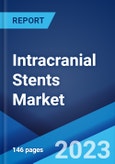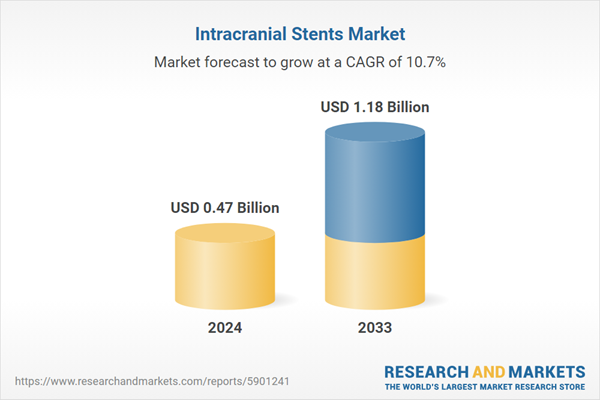The global intracranial stents market size reached USD 473.4 Million in 2024. Looking forward, the publisher expects the market to reach USD 1.18 billion by 2033, exhibiting a growth rate (CAGR) of 10.2% during 2025-2033. The rising prevalence of various cerebrovascular disorders, rapidly growing geriatric population, and shifting preference among patients and healthcare providers towards non-invasive and minimally invasive procedures represent some of the key factors driving the market.
Intracranial stents refer to small, tubular medical devices that are made from biocompatible materials such as nitinol or stainless steel, specifically designed for treating various cerebrovascular conditions in a less invasive way. They are characterized by improved compatibility with multiple imaging techniques, allowing precise navigation through blood vessels and are therefore deployed at the target site, with various sizes and configurations available to accommodate individual anatomical features. They are most commonly installed within narrowed or weakened blood vessels in the brain to provide structural support and restore blood flow. By maintaining vessel patency, they provide enhanced blood flow to the brain which helps in reducing the risk of stroke and other complications associated with restricted or damaged blood vessels. Intracranial stents find extensive applications in surgeries and procedures such as angioplasty or endovascular coiling, to treat various conditions including intracranial aneurysms or stenosis. Some of the advantages provided by intracranial stents include long-term support to blood vessels, shorter recovery times, and reduced hospital stays.
Intracranial stents refer to small, tubular medical devices that are made from biocompatible materials such as nitinol or stainless steel, specifically designed for treating various cerebrovascular conditions in a less invasive way. They are characterized by improved compatibility with multiple imaging techniques, allowing precise navigation through blood vessels and are therefore deployed at the target site, with various sizes and configurations available to accommodate individual anatomical features. They are most commonly installed within narrowed or weakened blood vessels in the brain to provide structural support and restore blood flow. By maintaining vessel patency, they provide enhanced blood flow to the brain which helps in reducing the risk of stroke and other complications associated with restricted or damaged blood vessels. Intracranial stents find extensive applications in surgeries and procedures such as angioplasty or endovascular coiling, to treat various conditions including intracranial aneurysms or stenosis. Some of the advantages provided by intracranial stents include long-term support to blood vessels, shorter recovery times, and reduced hospital stays.
Intracranial Stents Market Trends:
The global market is primarily driven by the rising prevalence of various cerebrovascular disorders such as cerebral aneurysms and strokes. This can be attributed to the rapidly growing geriatric population that is more susceptible to developing these ailments. In line with this, continual technological advancements in intracranial stent production resulting in innovative and advanced products with improved flexibility, navigability, and radial strength are fueling the market. Moreover, an enhanced emphasis on early diagnosis and treatment of neurological conditions is propelling the demand for effective treatment solutions, which in turn is resulting in a higher uptake of intracranial stents. Also, the shifting preference among patients and healthcare providers towards non-invasive and minimally invasive procedures with shorter recovery times is acting as a significant growth-inducing factor for the market. In addition to this, favorable reimbursement policies for intracranial stent procedures by government agencies and private insurance providers in several countries is creating a positive market outlook. The market is further fueled by various strategic collaborations, merger and acquisitions (M&As) and partnerships among key players to expand their market presence. Apart from this, numerous innovations in medical imaging technologies, such as magnetic resonance imaging (MRI), computed tomography (CT), and angiography are impacting the market positively. Some of the other factors contributing to the market include rapid urbanization, rising healthcare expenditure, upgradation of hospital infrastructure, particularly in developing countries and extensive research and development (R&D) activities.Key Market Segmentation:
The publisher provides an analysis of the key trends in each segment of the global intracranial stents market, along with forecasts at the global, regional, and country levels from 2025-2033. Our report has categorized the market based on type, application, and end user.Type Insights:
- Self-Expanding Stents
- Balloon Expanding Stents
- Stent-Assisted Coil Embolization
Application Insights:
- Intracranial Stenosis
- Brain Aneurysm
End User Insights:
- Hospitals
- Ambulatory Surgery Centers
Regional Insights:
- North America
- United States
- Canada
- Asia Pacific
- China
- Japan
- India
- South Korea
- Australia
- Indonesia
- Others
- Europe
- Germany
- France
- United Kingdom
- Italy
- Spain
- Russia
- Others
- Latin America
- Brazil
- Mexico
- Others
- Middle East and Africa
Competitive Landscape:
The report has also provided a comprehensive analysis of the competitive landscape in the global intracranial stents market. Detailed profiles of all major companies have been provided. Some of the companies covered include Acandis GmbH, Balt Group, Medtronic Public Limited Company, MicroPort Scientific Corporation, Phenox GmbH, Stryker Corporation, Terumo Corporation, etc. Kindly note that this only represents a partial list of companies, and the complete list has been provided in the report.Key Questions Answered in This Report:
- How has the global intracranial stents market performed so far, and how will it perform in the coming years?
- What are the drivers, restraints, and opportunities in the global intracranial stents market?
- What is the impact of each driver, restraint, and opportunity on the global intracranial stents market?
- What are the key regional markets?
- Which countries represent the most attractive intracranial stents market?
- What is the breakup of the market based on the type?
- Which is the most attractive type in the intracranial stents market?
- What is the breakup of the market based on the application?
- Which is the most attractive application in the intracranial stents market?
- What is the breakup of the market based on the end user?
- Which is the most attractive end user in the intracranial stents market?
- What is the competitive structure of the global intracranial stents market?
- Who are the key players/companies in the global intracranial stents market?
Table of Contents
1 Preface3 Executive Summary11 Value Chain Analysis13 Price Analysis
2 Scope and Methodology
4 Introduction
5 Global Intracranial Stents Market
6 Market Breakup by Type
7 Market Breakup by Application
8 Market Breakup by End User
9 Market Breakup by Region
10 Drivers, Restraints, and Opportunities
12 Porters Five Forces Analysis
14 Competitive Landscape
List of Figures
List of Tables
Companies Mentioned
- Acandis GmbH
- Balt Group
- Medtronic Public Limited Company
- MicroPort Scientific Corporation
- Phenox GmbH
- Stryker Corporation
- Terumo Corporation
Methodology

LOADING...
Table Information
| Report Attribute | Details |
|---|---|
| No. of Pages | 141 |
| Published | March 2025 |
| Forecast Period | 2024 - 2033 |
| Estimated Market Value ( USD | $ 0.47 Billion |
| Forecasted Market Value ( USD | $ 1.18 Billion |
| Compound Annual Growth Rate | 10.7% |
| Regions Covered | Global |
| No. of Companies Mentioned | 7 |









